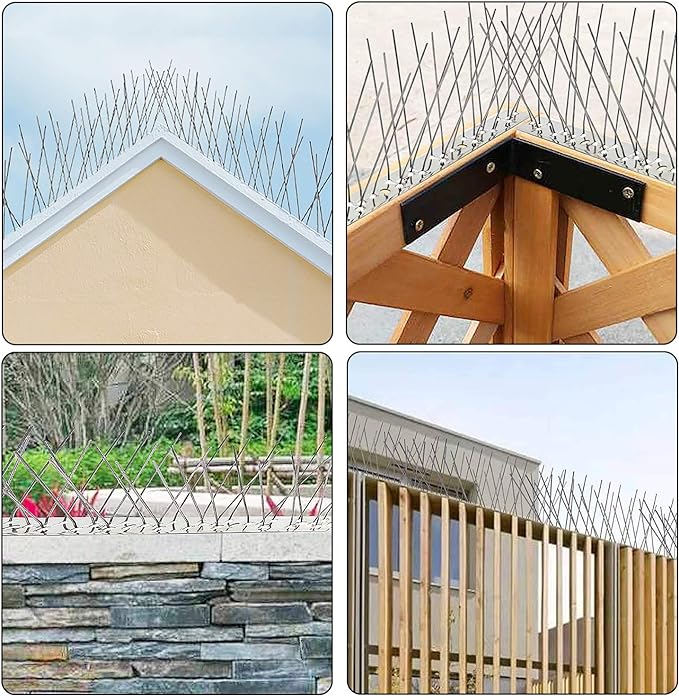Hard metal spikes installed by humans to prevent birds from roosting have been found in nests across Europe. Birds cleverly violate their purpose: they tear them away from buildings and use them to strengthen their homes and protect their offspring.
“They actually use these anti-bird spines to protect themselves,” Auke-Florian Hiemstra, lead author of a study on bird nests published this week, said in an interview. Their nests… are like a perfect comeback.” “These rebellious birds are smarter than us.”
The birds – mostly corvids, including magpies and crows – have been found building nests in Scotland, the Netherlands and Belgium, built with “hostile” architecture, Hiemstra said.
He said the metal spikes are believed to provide “structural support” to the nest, in some cases forming a dome-shaped roof. Hiemstra added that they can also be used to “defend the nest,” driving away predators and protecting the eggs, making the “nest look like a fortress.” His research was published in Deinsea, the online journal of the Natural History Museum Rotterdam.
A researcher of artificial materials for animal structures from the Netherlands Center for Natural Biodiversity and Leiden University said he first discovered such a bird’s nest in the courtyard of a hospital in Antwerp, Belgium, on a patient. Hiemstra said the massive structure contained about 1,500 metal spikes, or about 50 meters of bird-proofing pins, that were likely removed from the hospital roof.
Hiemstra suggests that this unusual behavior may indicate some kind of “evolutionary advantage” as the birds seek alternatives to natural, thorny plant material for nesting, choosing instead sharper man-made objects such as thorns or barbed wire. “Animals always focus on material things for their own gain,” he added.
Jim Reynolds, associate professor of ornithology and conservation at the University of Birmingham, who was not involved in the study, agrees that “repurposing” material is an adaptive technique for birds that “live and breed in cities.”
This may have another benefit, he says: Shiny, spiky food in the nest can be seen as a “quality indicator” of a potential feathered mate, indicating the bird has a good home and will make a good companion.
Reynolds said he was “not surprised at all” by the birds’ cunning behavior, noting that the intelligent corvid species has long intrigued ornithologists “because of their tool-making abilities and cognitive abilities.”
Bird spikes are often placed in train stations, parking lots or on the roofs of buildings to prevent animals from roosting. Similar hostile designs sometimes appear on doorways and benches to prevent people from living or sleeping on the streets of cities around the world.
“It appears that the birds may be retaliating against our bird control tactics,” he added.
Mark Mainwaring, an ornithologist and lecturer at Bangor University in Wales, warns that while the approach is innovative, it can still cause some concern. This week he published a separate study about birds incorporating “human materials” such as candy wrappers and plastic rope into their bodies. Their lair.
For example, metal spikes can cool down at night and harm chicks. Some types of trash collected can be toxic or harmful to animals, he said, although other trash, such as cigarette butts, may have some benefit in killing vermin. Colorful litter can also have the unfortunate effect of attracting predators, Mainwaring said.
He encourages more people to look around their yards outside of active breeding season and share photos of these mixed-material nests. Mainwaring’s research was published in the Journal of the Royal Society.
According to American architect Joyce Hwang, birds’ adaptive behavior is “beautiful and ironic,” she says.
Modern city buildings often have a variety of “bird deterrents” including shock wires, nets and spikes – often to prevent “guano” from appearing nearby – but “birds are still finding ways” to roost and make their home famous, she said.
Huang, an assistant professor of architecture at the University at Buffalo, said other approaches may offer better solutions, such as slopes and angled windows to discourage birds from nesting.
Essentially, she said, bird-proof spikes or scarers could signal the almost controlling nature of human behavior over nature.
“I think it’s a kind of poetic justice,” Huang said of the birds destroying materials designed to contain them. “It’s quite remarkable.”
Post time: Nov-10-2023
